Silver: Born of Cataclysmic Events and Brought to Us by Improbable Happenings
Synopsis of the October Program presented by Patrick Rowe
by Andy Thompson, MSDC Secretary
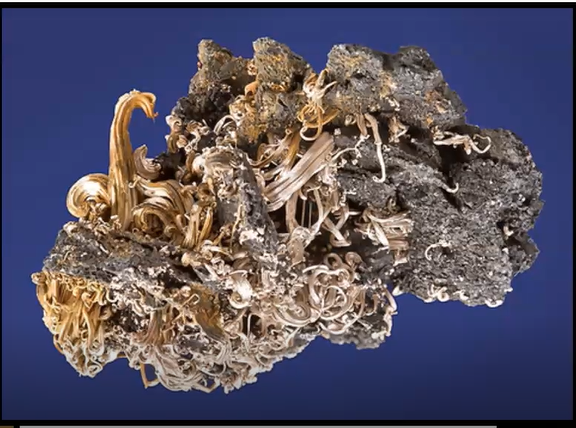
Patrick Rowe, MSDC’s October presenter, captured the audience’s attention from the very beginning:
“Geology was a seamless part of our family activities.”
As the son of a geologist, Patrick noted that he has been collecting rocks since he was five years old. Fast forward to his training as an engineer and that interest expanded, with a strong basis in geology and earth sciences. Today he is a Project Engineer for the Los Alamos National Laboratory and has continued to work with mineral clubs and the Los Alamos Geological Society. He serves as the Chairman for Paleontology for the Rocky Mountain Federation of Geological Societies. He leads field trips and also works with the Future Rockhounds of America Pebble Pups Program.

We hope that this synopsis of Patrick’s presentation will encourage you to view the YouTube video of Patrick’s story about silver (just over one hour in length). Some would describe it as everything interesting you would want to know about the origins and influence of silver. If you are willing to be fascinated by Patrick’s “field trip” into silver, go to the link HERE and enjoy his wonderful presentation.
Patrick provided a succinct summary of his presentation’s structure with the following six points:
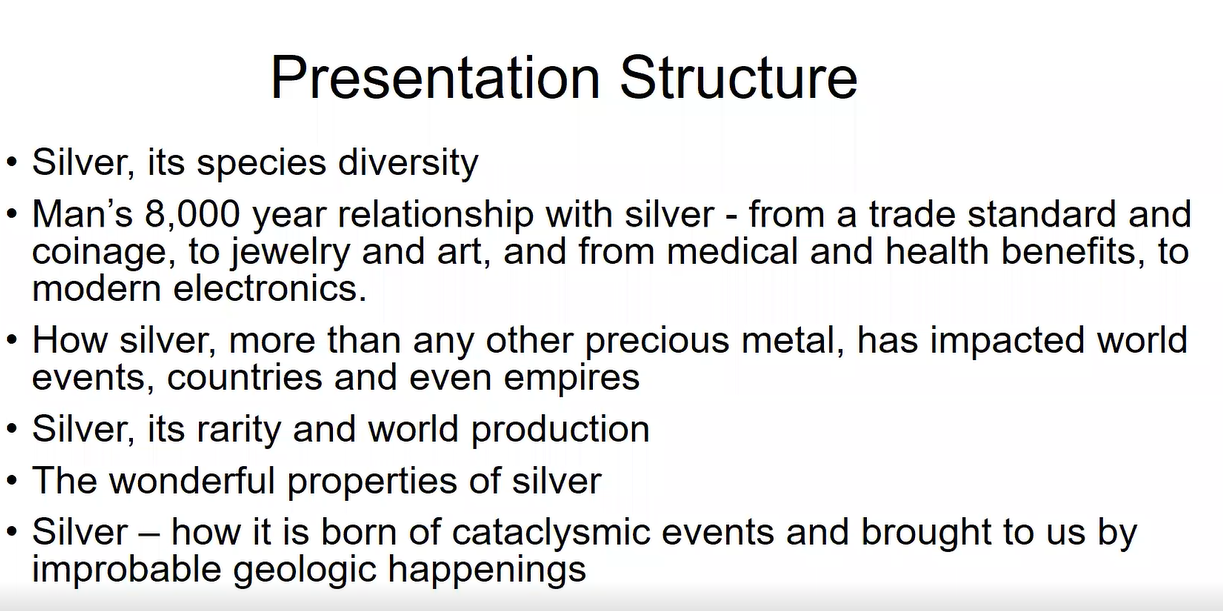
The following summary provides a snapshot of each of his six themes, illustrated by a few of his many power point images.
Silver, its Species Diversity
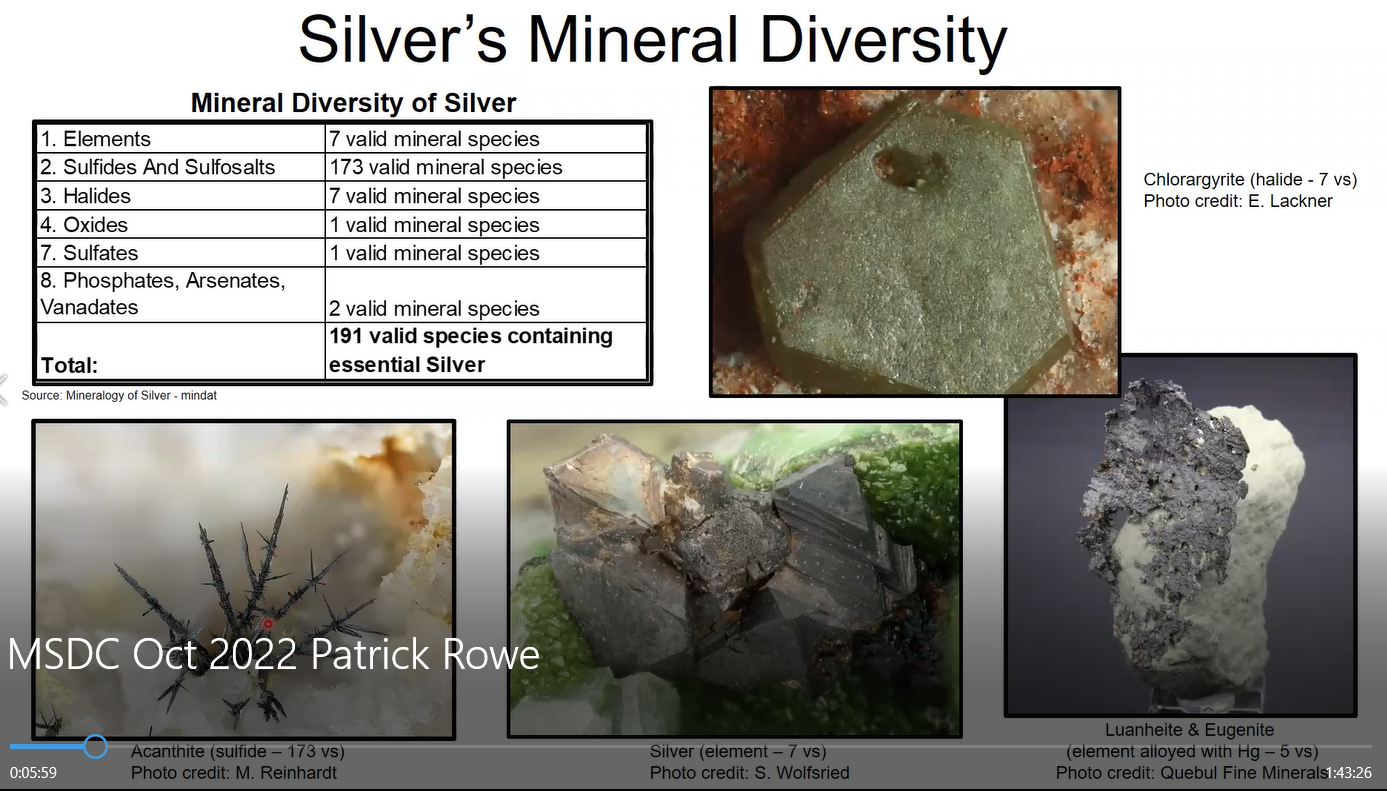
There are 191 valid species of minerals containing silver (Strunz-mindat, August 2022), compared to 39 valid species containing gold; and 752 valid species containing copper. The beauty and diversity of silver minerals’ habits is extraordinary.
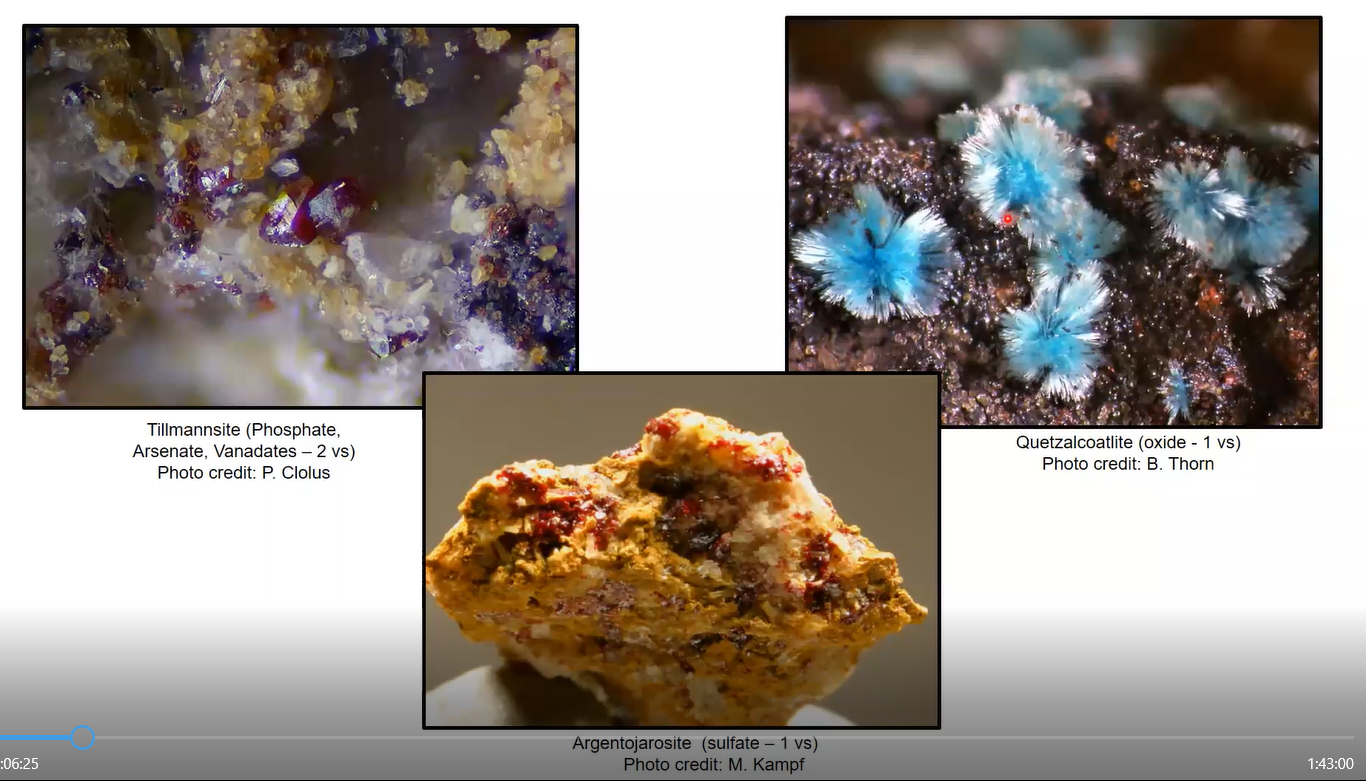
Man’s 8,000-year Relationship with Silver
For almost 8,000 years, man has had a coveted relationship with silver. Copper is the only metal that people have been mining and working with longer than they have with silver. People have been working with native copper for 11,000 years and with native silver for 8,000 years. Workers have been smelting it for 6,000 years.

How Silver Impacted World Events and Empires
Silver was traded throughout the Mediterranean region and formed a durable standard of trade that led directly into coinage around 600 BCE. Greece had a plethora of working silver mines near Athens as early as 700 BCE. It is estimated that the Greek silver mines shown on the map below, between 600 and 300 BCE, produced one million troy ounces of silver per year. The information on their silver coins helped preserve Greece’s ancient history. Their silver helped them to construct ships that were superior to the much larger navy of the Persian King Xerxes and helped the Greeks prevail in battles.
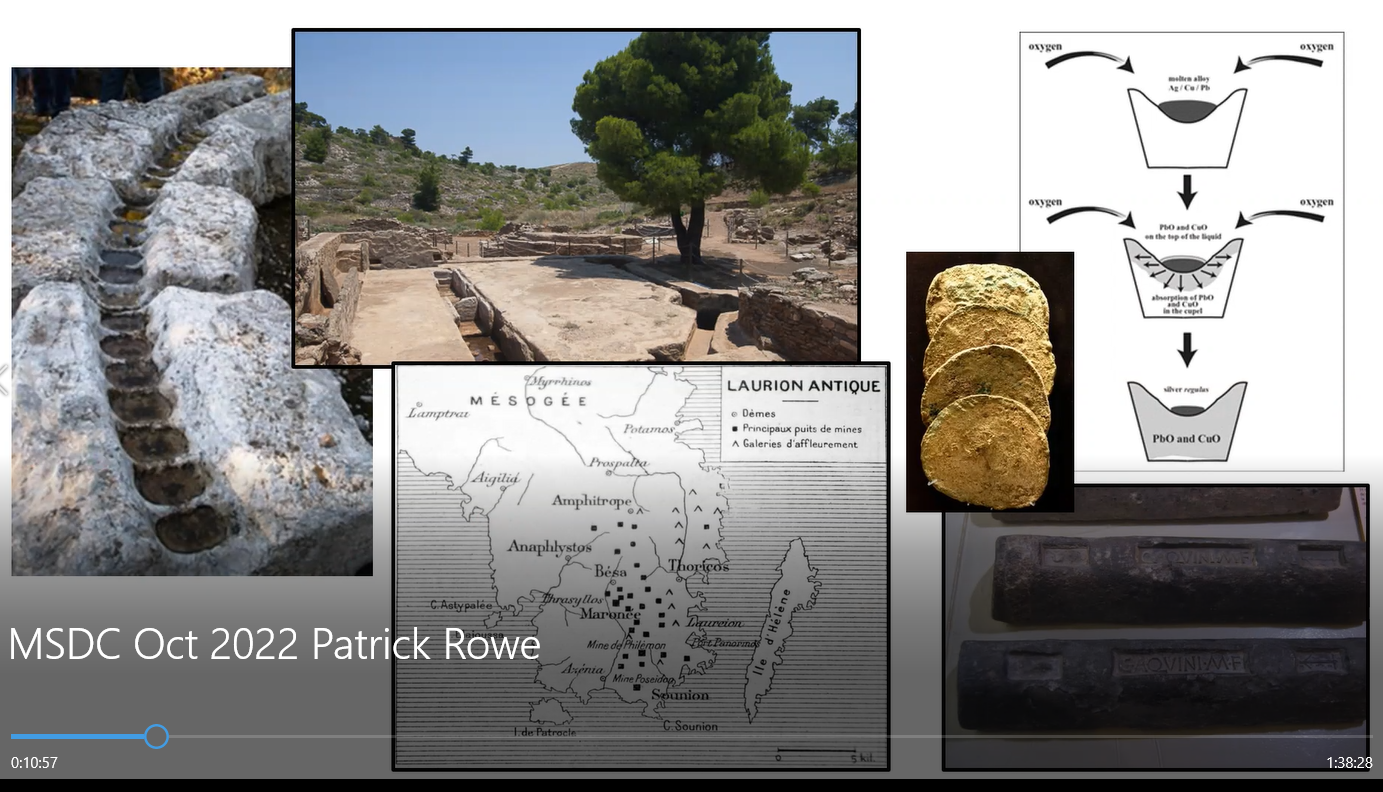
Historically, silver coins became a standard of trade as suggested below.
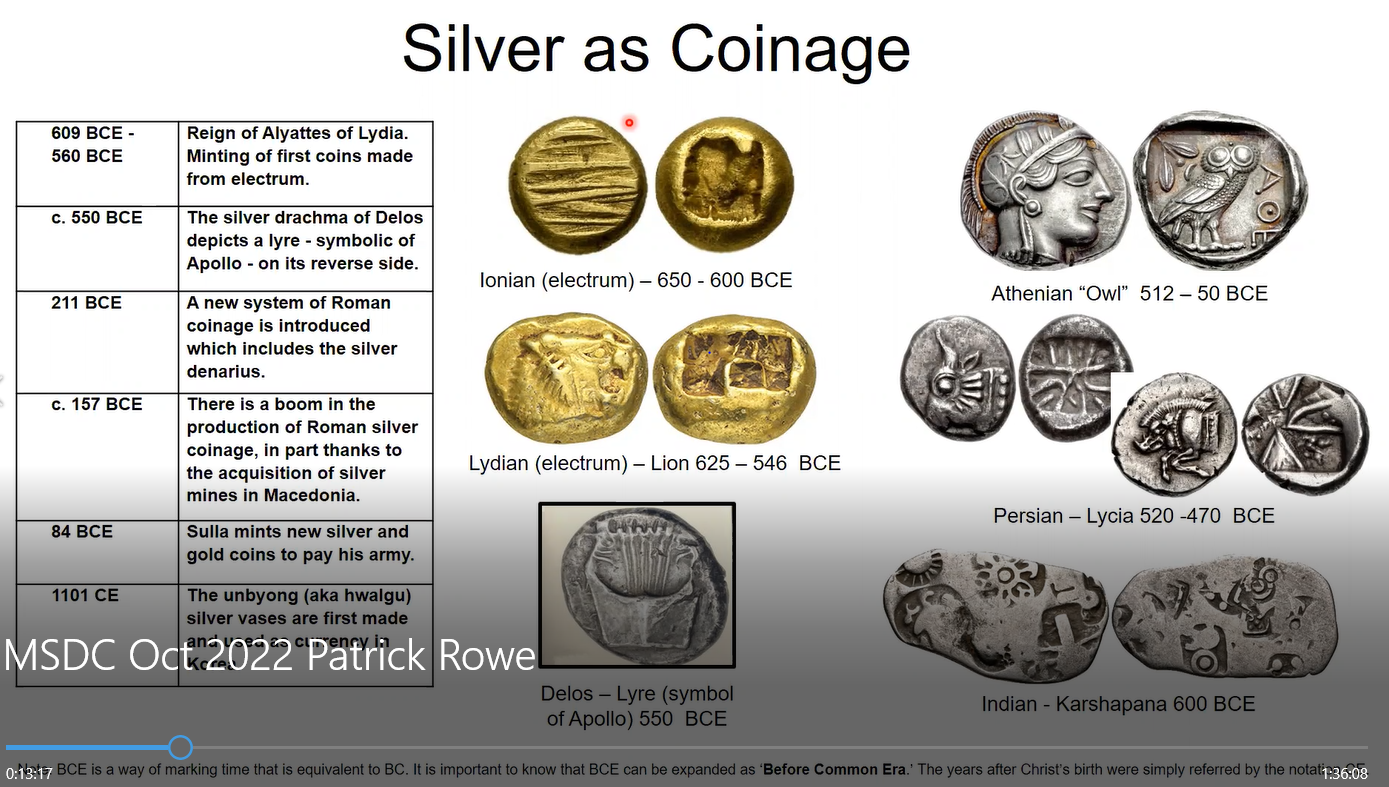
Consequently, silver played a significant role in the rise of the Greek and Austro-Hungarian Empires and helped finance Columbus’ voyage of discovery. However, no other single event in silver’s history rivals its discovery in the Americas following Columbus’ landing in the New World in 1492. The events that unfolded in the following years changed the face of silver and the world forever.
Silver, its Rarity and World Production
As the map below indicates, not only did silver become the coinage of world trade, but a lot of the world’s silver ended up in China. China highly valued silver as worth half the value of gold. That 2 to 1 ratio is low, compared to the average 16 to 1 standard used throughout Europe. The "new" Chinese tax law in 1580 initiated and encouraged tax payments to be made in silver. As a result, the European Renaissance and Japanese traders paid for Chinese silk, porcelain and other goods in silver. This comparatively high exchange rate benefitted other nations and resulted in much of their silver ending up in China.
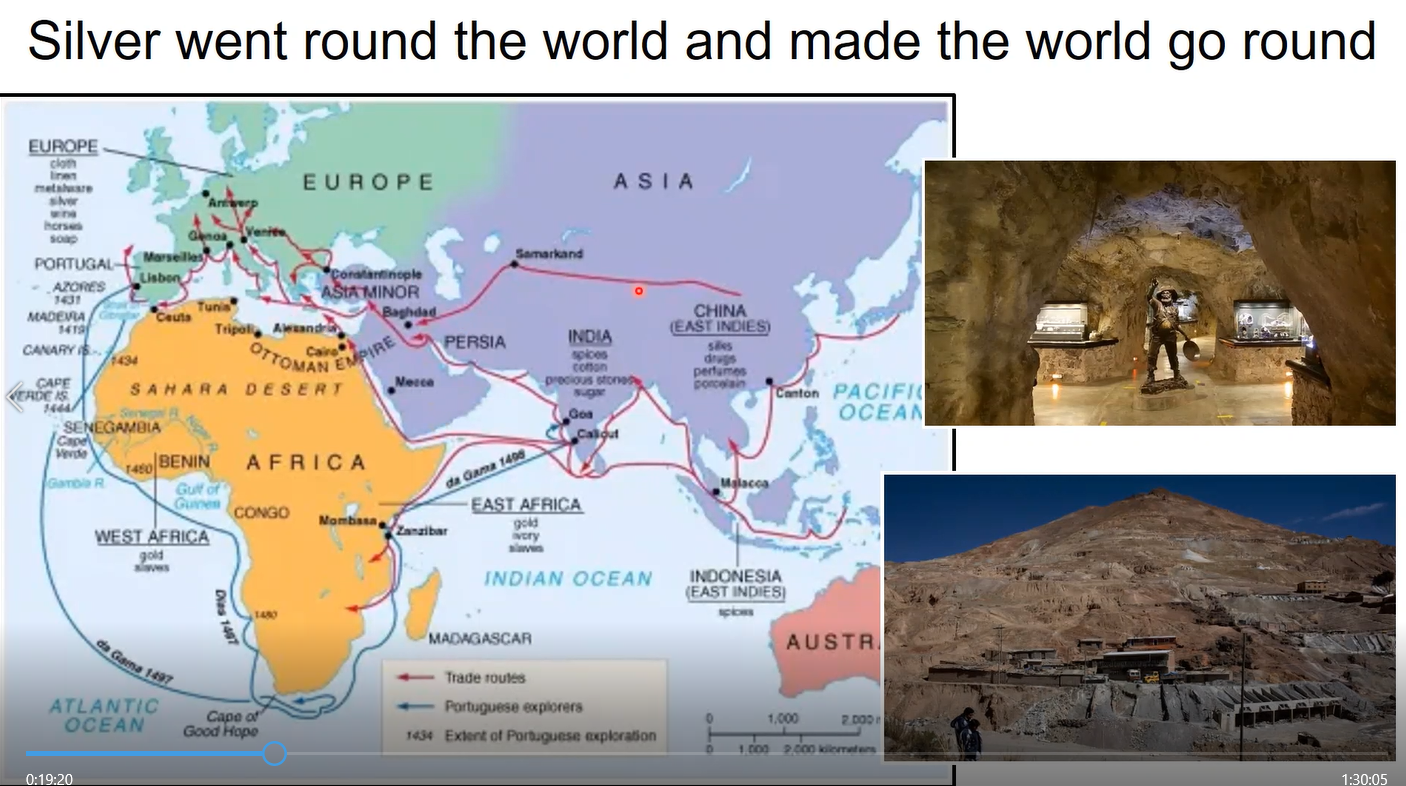
Patrick also mapped out five stages of silver mining in the U.S. and gave a marvelous explanation of the little-recognized, but famous, parody of how the Eastern bankers in New York in the late 1800s were ruining the mid-west farmers and industrial workers by denigrating the value of silver.
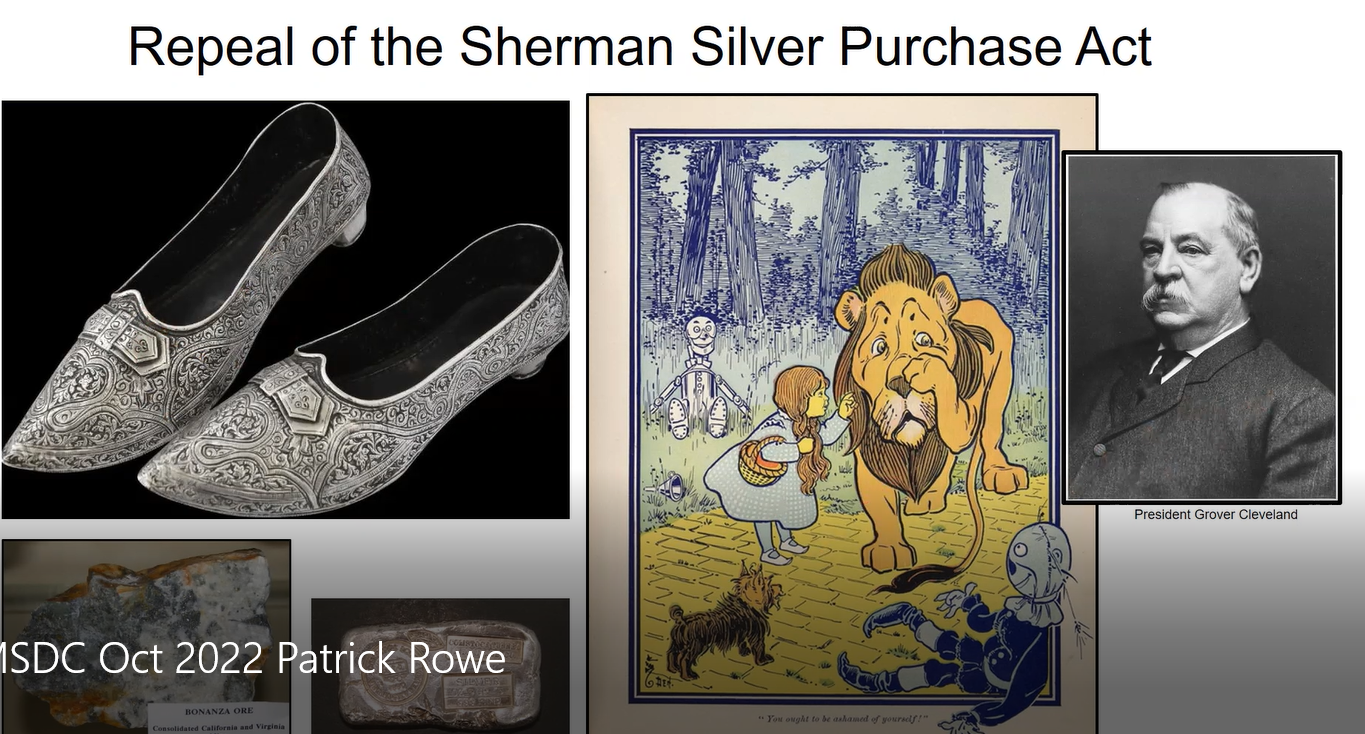
Patrick explained the fascinating U.S. precious metals history by identifying how the “The Wonderful Wizard of Oz” classic story by Frank Baum (1900) was actually a portrait of the contentious value relationship between silver (the ruby slippers were originally silver) and gold (the yellow brick road).
Simply put, the bankers (wicked witch of the East) were hurting the farmers (scarecrow) and industrial workers (tin man). The ineffective politicians (lion), though strong, lacked courage to stop the bankers. Dorothy’s silver slippers represented silver as a panacea protecting her (Kansas farmers) from the dead-end yellow brick road (overpriced gold).
Listen to Patrick’s concise explanation if you want to understand how the silver gold ratio has played an important role in the U.S. economy!
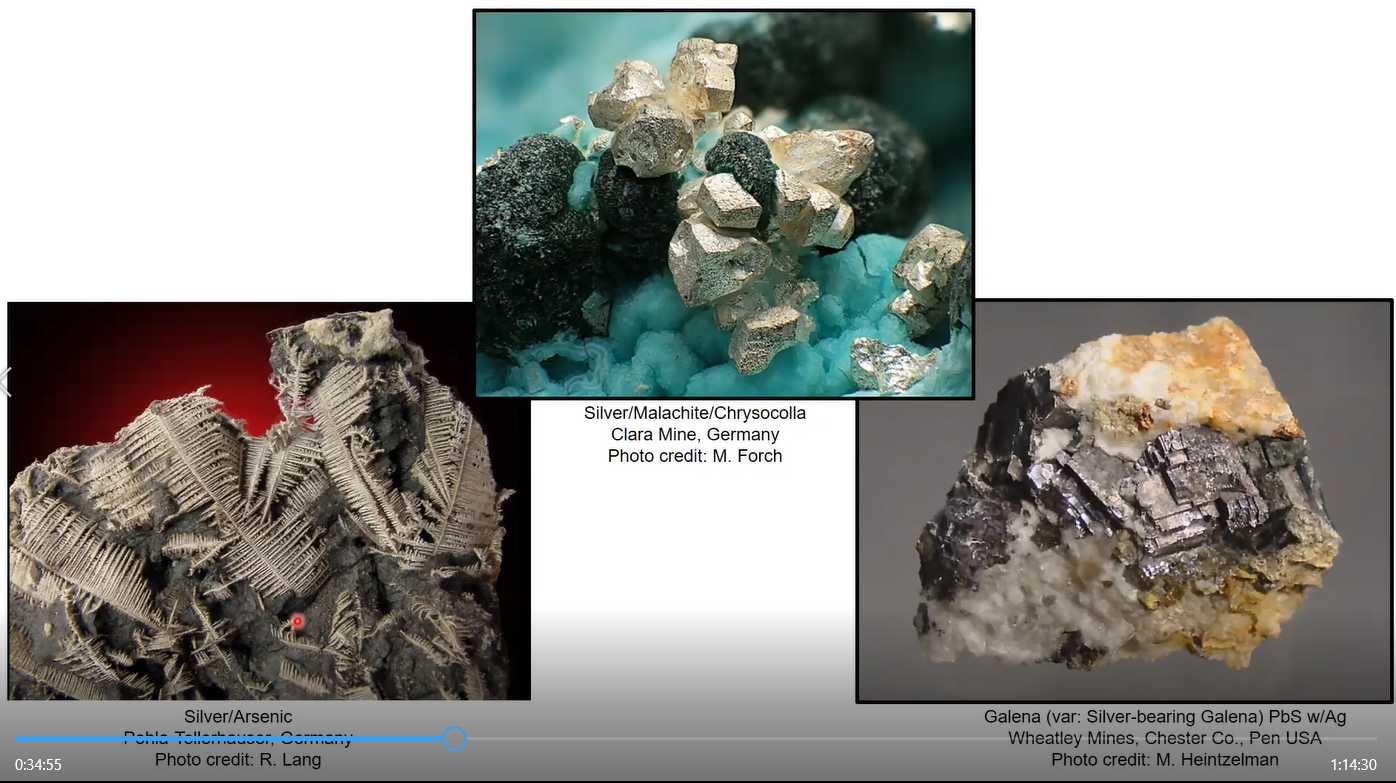
Throughout Patrick’s presentation, he provided abundant examples of colorful and diverse species of silver minerals. Those beautiful images lightened and balanced his detailed narrative about silver’s history and importance.
He pointed out two of his favorite silver specimens, below and to the right, from Mexico and Norway respectively, which he especially appreciates for their beauty and sculptural qualities.

Silver, its Wonderful Properties
Historically silver has been recognized as a disinfectant since the time of Alexander the Great who on his military campaigns drank only water infused with silver coins. Today’s medical practices also employ various forms of silver in caring for burns and diverse wounds and fighting infections.
Patrick also noted that silver has a higher thermal and electrical conductivity than either gold or copper. Silver is very malleable and can be hammered so thin that 100,000 sheets would stand only one inch high. Its reflectivity in the visible wavelengths exceeds that of copper, gold and aluminum.
With regard to how silver is used today, the following chart illustrates that electrical and electronic applications use the lion’s share of available silver, more than jewelry, coins, bars, and silverware combined.
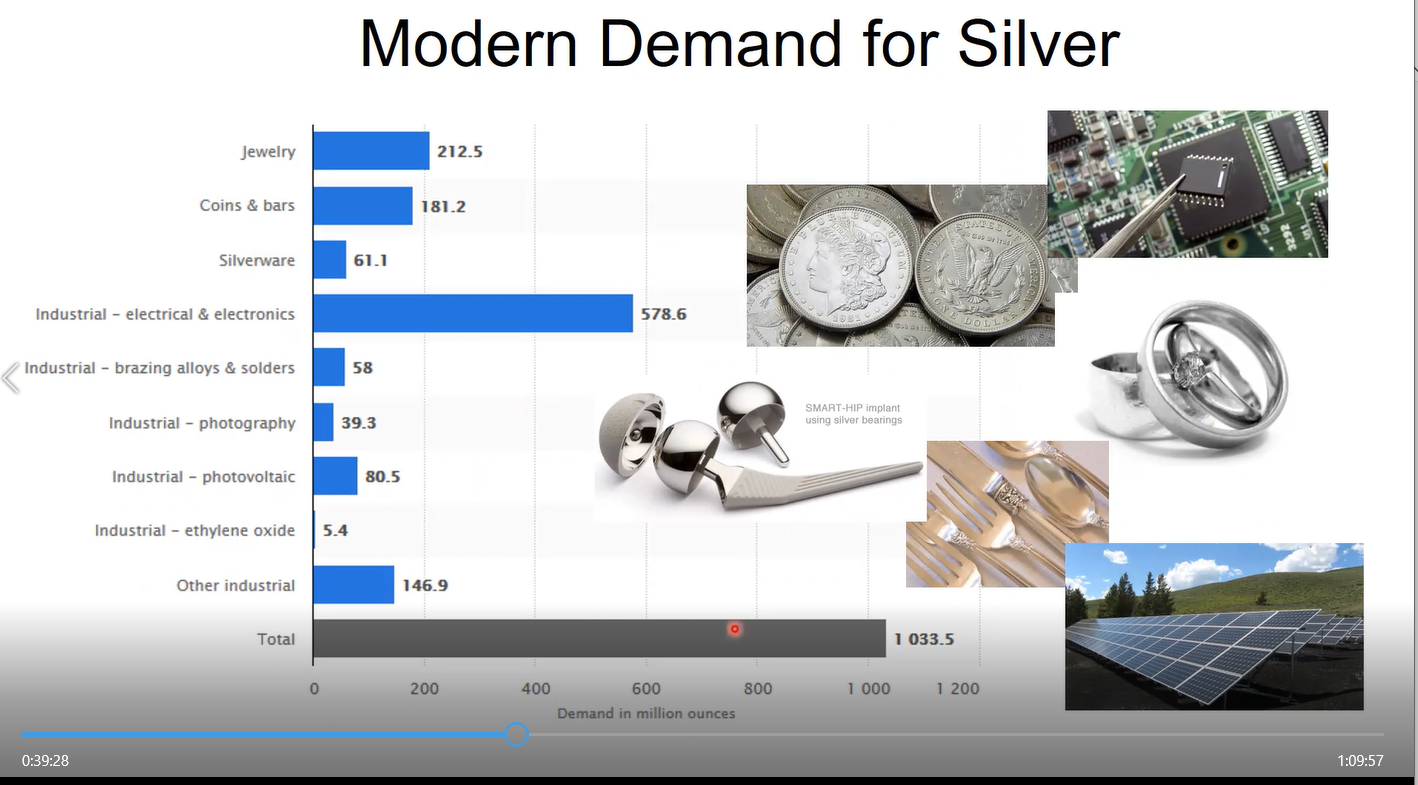
With extensive knowledge of silver-based minerals come many surprising insights. Below, Patrick noted, is a proustite (silver sulfide) specimen, which is a magnificent ruby-red colored silver and is actually “transparent.”
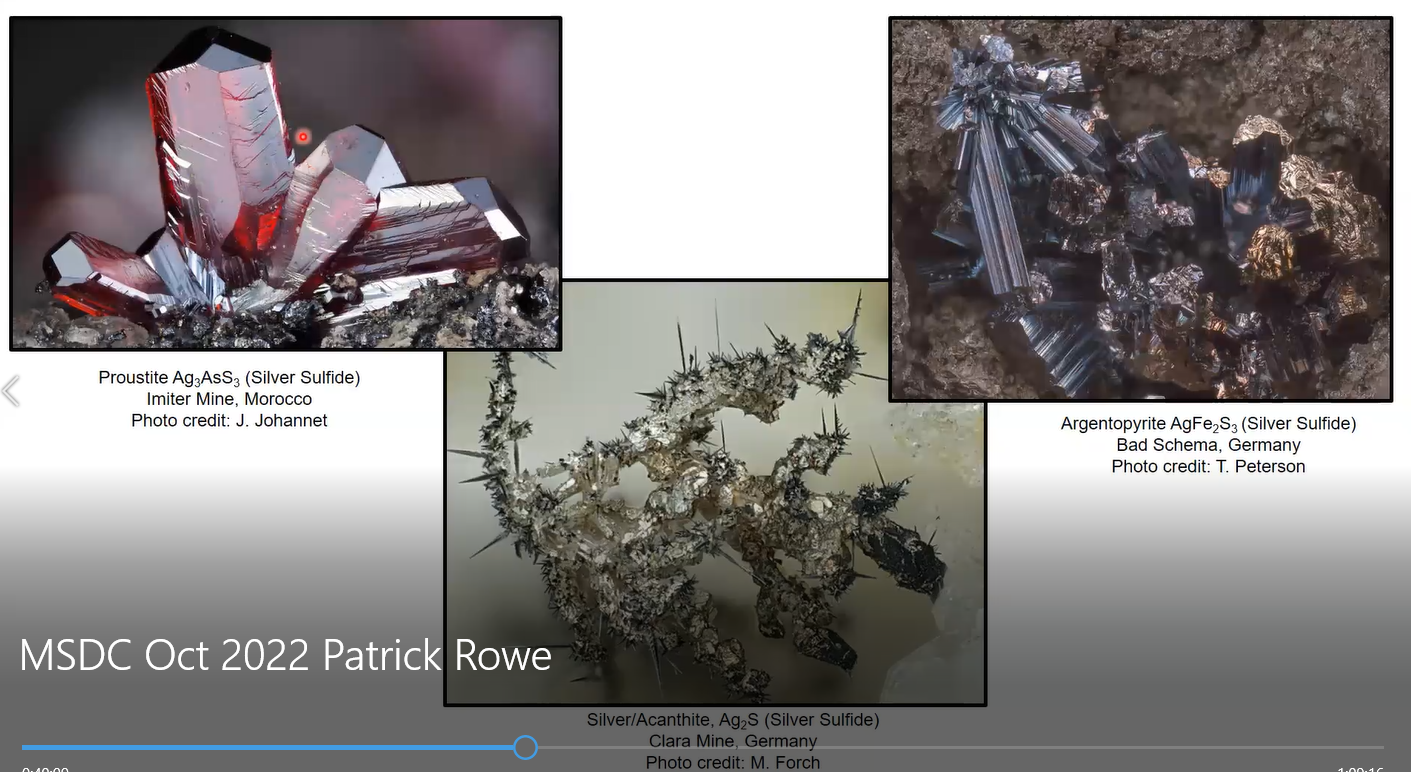
Similarly astounding for Patrick is the above specimen of argentopyrite (silver sulfide) which illustrates how the presence of silver transforms the normally gold-colored cubic pyrite into a longer and purple column-like rectangle (for more on pyrite, see the "Jeopardy Question" article elsewhere in this newsletter).
Silver, Born in Cataclysmic Events and Available through Tectonic Movements
Remember, Patrick’s presentation has been focused on the origins and destiny of silver. Now we get to the first part, how silver originates in the universe and how it made its way to Earth and became somewhat available in Earth’s crust.

Only in recent years have the worlds of astronomy and physics combined to give us an explanation of how each of the elements in the above Periodic Table originated as a function of the temperature of our initially expanding universe and subsequent exploding stars.
The formation of the simple and relatively lighter elements such as hydrogen and helium, shown above in blue, occurred during the Big Bang fusion at hot but relatively low temperatures – whereas the formation of heavier elements, beyond iron (#26 on the Periodic Table), required increasingly higher levels of temperature.
The formation of those heavier silver (and gold) elements, the focus of Patrick’s talk, is colored in the Periodic Table mainly in purple. Scientists have recently determined that the formation of these larger atoms occurred primarily from the cataclysmic merging of neutron stars.
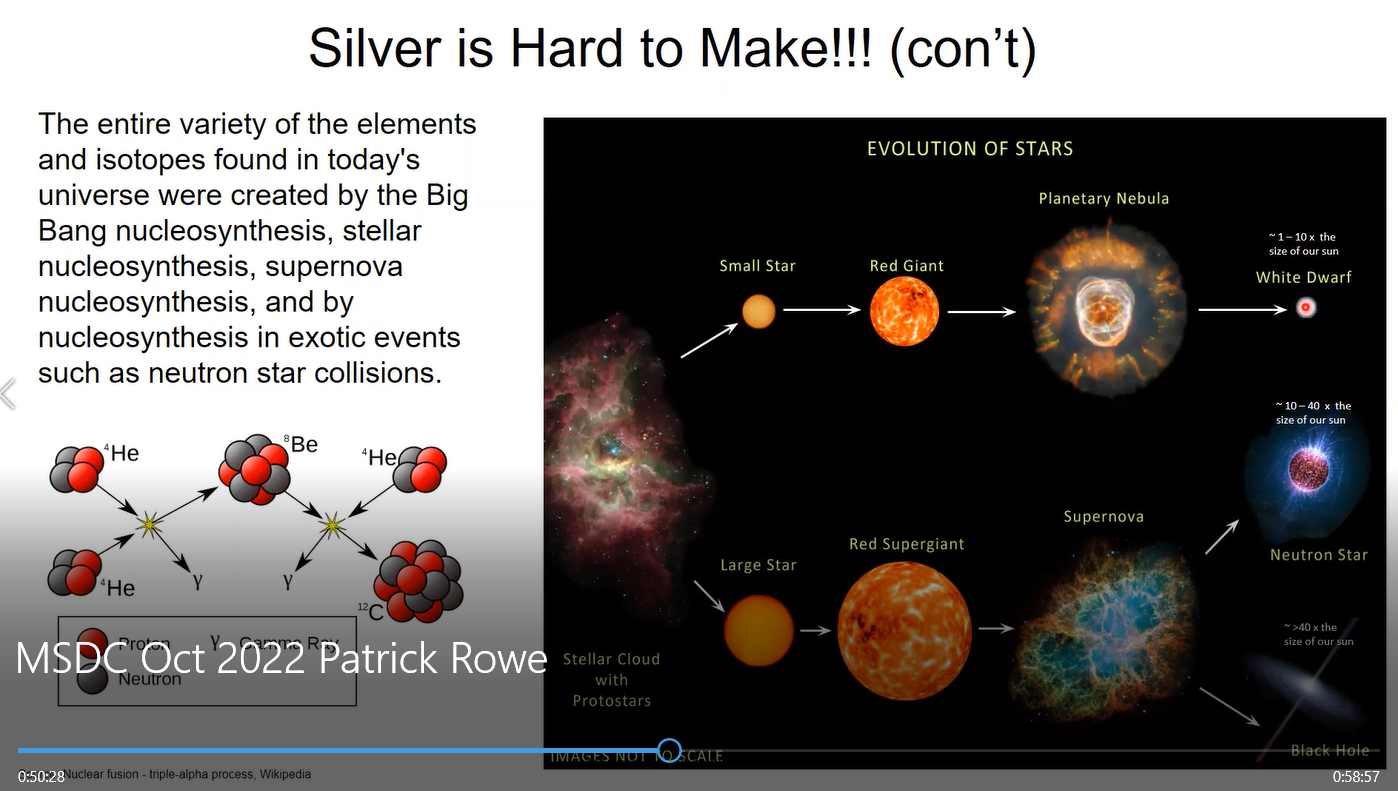
Simply put, a small amount of silver originates from the extremely rapid collapse of red giant stars. The dying red stars burn up all their smaller elements, including oxygen and carbon, and then their collapse takes place. At that point, the pressure at the core is so high, electrons are pressured to bond with protons, creating star cores made mainly of neutrons.
That neutron formation generates the emission of neutrinos that explode outward, superheating the iron at the red star’s surface. That heat transforms the iron and heavy elements at the dying star’s surface, thereby beginning the generation of small amounts of silver and gold which is expelled into space leaving behind a collapsed neutron star. Those small amounts of precious metals are represented by the green color in the silver (Ag, #47) box in the above Periodic Table.
Alternatively, when neutron stars totally collapse into super-dense masses without exploding into space, they become black holes.
Additionally, there has been a second scenario Patrick described which may have contributed to the formation of most of our heavier elements such as silver and gold. “About half the stars in our universe are binary,” and they revolve around their common gravitational core. When they merge, there is again a massive explosion of heated elements which fosters the merging of lighter elements and neutron absorption, thereby creating the majority of Earth’s heavier elements including silver and gold.
That leaves the final question Patrick addressed of how the silver and gold moved from the deeper levels closer to the core or our planet up toward the Earth’s surface and ultimately became our precious metal mines. The current thinking is that when Earth was forming, it was in the direct line of one of these highly heated streams of silver and gold exploding outward from explosive merging of binary neutron stars. Those heavier silver and gold elements became part of the Earth’s inner regions. All the Earth’s layers settled into concentric circles ending with the mantle and crust on the outside, as illustrated below.
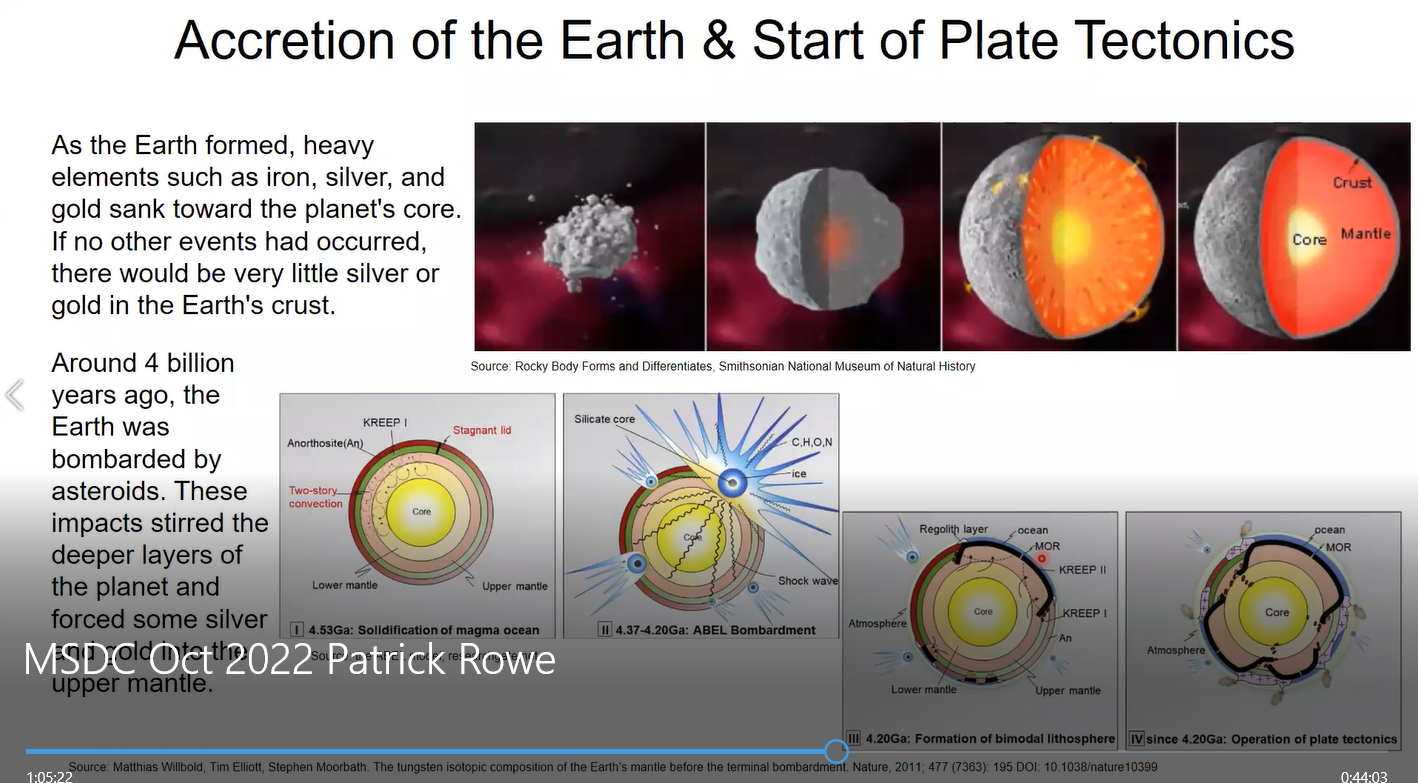
Patrick then used the above illustrations’ yellow figures of the Earth to suggest how the silver and gold gradually emerged from the deeper levels closer to the Earth’s core. Current thinking is that after the Earth’s structure became coherent, it experienced the bombardment of large, icy asteroids. That caused shock waves and cracks in the lower mantle which extended up through the crust. Plate tectonics generated further cracking and enabled the heavier elements to rise closer to the surface and eventually become the silver and gold mines, which is where Patrick’s story began with the Greek, Persian and Egyptian cultures.
"Take Away" Ideas about Silver
To conclude his presentation, Patrick provided the following summary for his audience.

MSDC’s President Kenny Reynolds thanked Patrick for his extraordinary presentation and for the clarity of his explanations. He then opened the floor for questions which were abundant. The scope of questions ranged widely and included how the gases of the post-neutron star explosions became solid metals within the earth and why the east coast of the U.S., compared to the western U.S., seems relatively devoid of gold and silver mines. Attendees also raised questions about the Earth’s unique structure and the seeming absence of plate tectonics on the other planets of our solar system.
After Patrick discussed the above and many additional questions, the audience expressed with strong applause their gratitude for his fine presentation.
